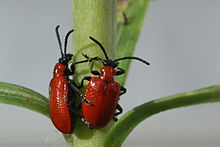Leaf beetle
| Leaf beetles | |
|---|---|

| |
| Scarlet lily beetle Lilioceris lilii in Oxfordshire, UK | |
| Scientific classification | |
| Domain: | Eukaryota |
| Kingdom: | Animalia |
| Phylum: | Arthropoda |
| Class: | Insecta |
| Order: | Coleoptera |
| Superfamily: | Chrysomeloidea |
| Family: | Chrysomelidae Latreille, 1802 [1] |
| Subfamilies | |
|
See text | |

Leaf beetles are the family Chrysomelidae. There are over 35,000 species in more than 2,500 genera, so it is one of the largest and most common of all beetle families. Many subfamilies are recognized.
Leaf beetles have a tarsal formula which appears to be 4-4-4, but is actually 5-5-5.[2] Some are difficult to tell from long-horned beetles (family Cerambycidae): it is done by the antennae not arising from frontal tubercles.
Adult and larval leaf beetles feed on all sorts of plant tissue. Their diversity has run parallel with that of the Angiosperms.[3] Many are serious pests of cultivated plants, for example the Colorado potato beetle (Leptinotarsa decemlineata), the asparagus beetle (Crioceris asparagi), the cereal leaf beetle (Oulema melanopus), and various flea beetles. A few act as vectors of plant diseases. Others can be used as biocontrol of invasive weeds. Most Chrysomelidae are conspicuously coloured, often in glossy yellow to red or metallic blue-green hues. Some (especially Cassidinae) have spectacularly bizarre shapes. They are highly popular among insect collectors.
Classification[change | change source]
Selection of notable sub-families:
- Subfamily Bruchinae – includes the bean weevils or seed beetles. They feed on seeds, some even on toxic seeds.
- Subfamily Cassidinae – includes the tortoise beetles and prickly leaf beetles. A recent offshoot of the Hispanae.
- Subfamily Chrysomelinae – includes the broad-bodied leaf beetles. "They defend themselves with a pot-pourri of toxins".[3]
- Subfamily Criocerinae – includes the asparagus beetles and lily beetles
- Subfamily Cryptocephalinae – includes cylindrical leaf beetles and warty leaf beetle. "The larvae eat dead leaves and carry a protective case made of faecal and debris particles".[3]
- Subfamily Donaciinae – includes the longhorned leaf beetles
- Subfamily Eumolpinae – includes the oval leaf beetles
- Subfamily Galerucinae – includes the flea beetles. The former subfamily Altricinae is included.
- Subfamily Hispanae – many are leaf miners.
- Subfamily Sagrinae – frog-legged beetles or kangaroo beetles, diverse in Australia. "They have spiny hind legs built like nutcrackers that grasp and impale attackers".[3]
Phylogeny[change | change source]
Records from the Cretaceous period are scarce: only three records are known.[3] An early Cretaceous origin from a more general form is suggested by Grimaldi and Engel.[3] Then came an Upper Cretaceous divergence of Chrysolmelid sub-groups, and adaptive radiation connected to that of the flowering plants.[3]
References[change | change source]
- ↑ "Chrysomelidae". Integrated Taxonomic Information System.
- ↑ "Family identification – Chrysomeloidea". University of Florida. Archived from the original on 2006-10-13. Retrieved 2006-11-29.
- ↑ 3.0 3.1 3.2 3.3 3.4 3.5 3.6 Grimaldi D. and Engel M.S. 2005. Evolution of the insects. Cambridge University Press, p394/5. ISBN 0-521-82149-5
